| United States map of 1865: Dark Blue: Union states; Light Blue: Union territories not permitting slavery; Tan: Border Union states, permitting slavery; Gray: Bleeding Kansas, entered Union; Red: Confederate states, Yellow: Union territories permitting slavery |
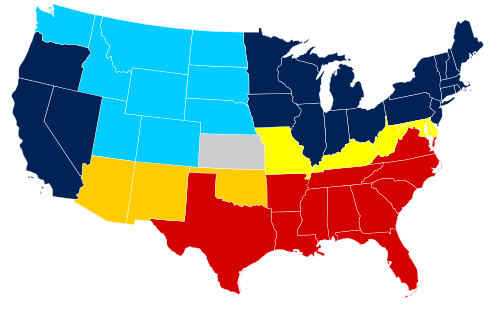
Topics on the Page
A. the Missouri Compromise (1820)
B. the South Carolina Nullification Crisis (1832-1833)
C. the Wilmot Proviso (1846)
D. the Compromise of 1850
E. the publication of Harriet Beecher Stowe’s Uncle Tom’s Cabin (1851-1852)
F. the Kansas-Nebraska Act (1854)
G. the Dred Scott Supreme Court case (1857)
H. the Lincoln-Douglas debates (1858)
I. John Brown’s raid on Harper’s Ferry (1859)
J. the election of Abraham Lincoln (1860)
Focus Question: What were the critical developments that led to the Civil War?
Practice Test:
Click here for practice test questions on the Civil War.
Timeline: Road to the Civil War
A. the Missouri Compromise (1820)
Read a full history of The Missouri Compromise of (1820) here
Read an Essay from Digital History on The Missouri Compromise here
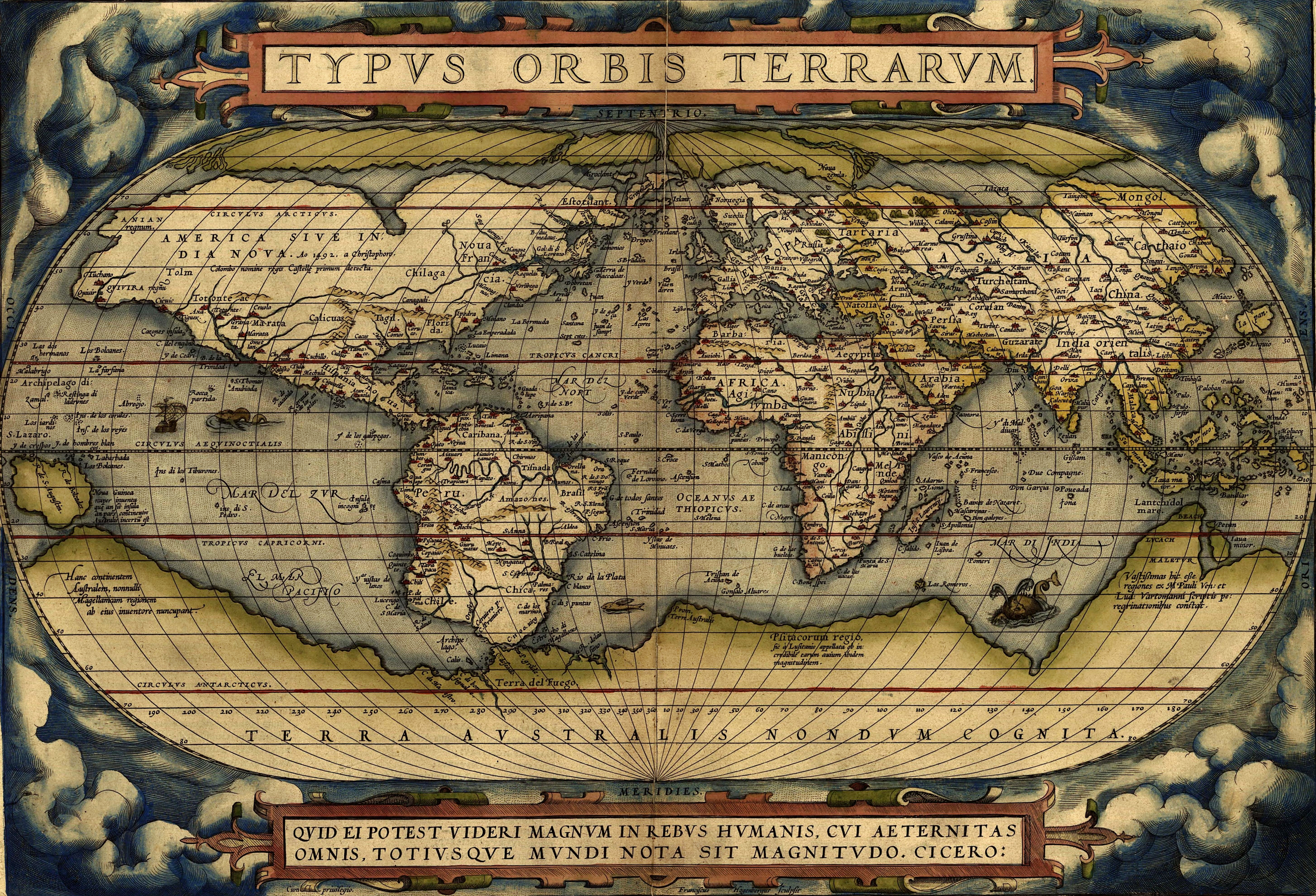 Play with an Interactive Map on the Missouri Compromise here
Play with an Interactive Map on the Missouri Compromise here
Henry Clay and the Struggle for the Union: The Missouri Compromise of 1820 (video)
key summary:
 |
| The US in the aftermath of the Missouri Compromise |
- In 1819-1820, the potential admission of Missouri as a new state created a crisis which would foreshadow future disputes over slavery.
- Slavery had long been practiced in Missouri, and Missouri's political leadership wanted it to continue after official statehood.
- But many in the North opposed the admission of another slave state, particularly since it would upset the then equal balance of 11 free states (NH, VT, MA, RI, CT, NY, NJ, PA, OH, IN, IL) and 11 slave states (DE, MD, VA, KY, TN, NC, SC, GA, AL, MS, LA).
- Northerners would particularly worried that the greater number of slave states would allow slave interests to overwhelm the senate.
Henry Clay, 1818
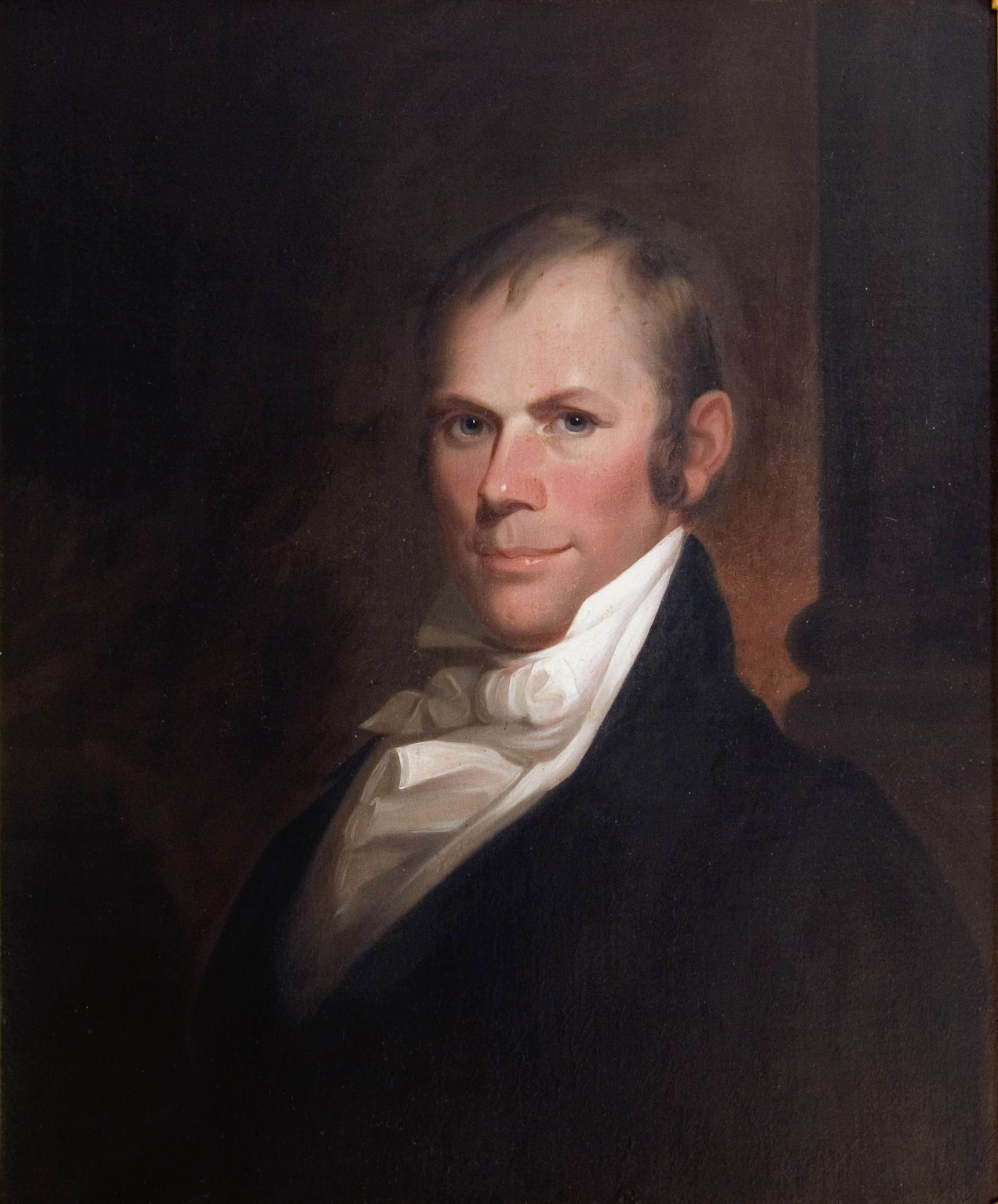
There was talk of secession and civil war, but the crisis was averted by the 1820 Missouri Compromise, negotiated by senators Henry Clay of Kentucky, Daniel Webster of Massachusetts, and John C. Calhoun of South Carolina.
- The compromise balanced Missouri's admission to the Union as a slave state with the admission of much of Massachusetts' northern territory as a free state. This northern territory of Massachusetts is now the state of Maine.
- The southern border of Missouri (the parallel 36°30′ north,36.5 degrees north latitude) became a demarcation line for the status of slavery in new states; states admitted to the south would be slave states while states to the north would be free states.
- No new territory north of the line (except the proposed borders of Missouri itself) would permit slavery.
Henry Clay's efforts at compromise earned him the name "The Great Compromiser," and his efforts were just the beginning of one of the greatest careers of any U. S. Senator. Hear more about this in the following video here
 A famous painting of Clay entitled Henry Clay in the United States Senate was restored in 2009.
A famous painting of Clay entitled Henry Clay in the United States Senate was restored in 2009.
Clay served in Congress for nearly 40 years, in both the House and the Senate, and was secretary of state under President John Quincy Adams. He was a contender for the Presidency five times, running three times in 1824, 1832, and 1844.
He was the founder of the Whig Party, and a early advocate for an expanded role for the federal government (see "The Rescue of Henry Clay" by Fergus M. Bordewich, Smithsonian Magazine, November 2009, p. 76-79).
Thomas Jefferson on the Missouri Compromise In 1820 Thomas Jefferson had been removed from public life for some time, but still alive at 77 years old he wrote a letter commenting on the grave consequences of the nation's ongoing slavery debate. He wrote, "this momentous question, like a fire bell in the night, awakened and filled me with terror. I considered it at once as the knell of the Union. it is hushed indeed for the moment. but this is a reprieve only, not a final sentence. a geographical line, coinciding with a marked principle, moral and political, once conceived and held up to the angry passions of men, will never be obliterated; and every new irritation will mark it deeper and deeper." These words proved prophetic, but they also show the power of the compromise itself in potentially delaying civil war.
AP US History Review Video: The Missouri Compromise
 Why did Missouri's application for statehood in 1819 cause a political crisis?
Why did Missouri's application for statehood in 1819 cause a political crisis?
a) The United States had equal numbers of slave and free states, and Missouri's entry would have upset the balance.
b) The United States had never established a state west of the Mississippi, and Missouri's entry would have likely caused conflict with American Indians.
c) Missouri was the center of abolitionist activity, and its admission would have antagonized Southern states.
d) Missouri was a center of secessionist activity, and its entry would have antagonized Northern states.
Correct Answer: A (2010 National Assessment of Education Progress; 45 percent of 12th graders got this question correct)
B. The South Carolina Nullification Crisis (1832-1833)
Watch the following video that gives a fun explanation of the crisis: US History: The Nullification Crisis
John C. Calhoun

How It Happens: The Nullification Crisis
Another major sectional dispute between Northern and Southern interests came with the passage of new federal tariff laws in 1828 and 1832.
- The highly controversial Tariff of 1828 (often referred to in the South as the "Tariff of Abominations") placed very high taxes on foreign imports, usually making them more expensive than goods produced domestically.
- This highly protective policy helped to encourage domestic industry, which was heavily based on the North. But while it helped Northern industry, it hurt Southern farmers, who relied on cheap foreign imports.
- Many in the South saw the tariffs as the result of a government which only responded to Northern interests, particularly during the presidency of John Quincy Adams.
- Many Southerners expected the tariffs to be reduced or eliminated under the presidency of Andrew Jackson, but Jackson did little to address their concerns. His Tariff of 1832 only slightly reduced tariffs, not nearly enough for most in South Carolina.
- Jackson's Vice President, South Carolinian John C. Calhoun, was one of the strongest anti-tariff advocates, and also an advocate of the principle of states' rights.
- Calhoun and the South Carolina state government favored and passed the 1832 Ordinance of Nullification, declaring the federal tariff law null and void in South Carolina.
- President Jackson held that the states could not trump federal law, and sent troops to South Carolina. Eventually a compromise was reached in the Compromise Tariff of 1833 (also engineered largely by Henry Clay, see above), which gradually reduced tariff rates to the satisfaction of South Carolina.
The tariff dispute was resolved, but the issue of states' rights would continue to be controversial in the future, particularly when applied to slavery and secession.
Library of Congress: Nullification Crisis Primary documents related to the Nullification Crisis
C. the Wilmot Proviso (1846)

Read The Wilmot Proviso (1846) from the Ohio History Connection
a. Introduced to the House of Representatives to resolve the Mexican-American War, the Wilmot Proviso proposed to ban slavery in the new lands acquired by the United States in the aftermath of the war. It represented a common Northern interest which held the war was waged to protect Southern slave interests.
b. Proposed by David Wilmot, a House member from Pennsylvania, the Proviso was to prevent the spread of slavery into the territory acquired from the Mexican-American war.
c. August 8, 1846, President Polk requested $2,000,000 from Congress to settle negotiations with Mexico.
d. When the Proviso was approved by the House, it sparked heated debate in the senate over slavery, free labor, and the competing interests of the North and South. While it passed in the House, it failed in the Senate multiple times (including its proposed inclusion in the Treaty of Guadalupe Hidalgo) due to the greater proportional representation of the South.
e. The South began to defend slavery, and its spreading into the new territories that had been acquired from Mexico.
f. In the 1848 presidential election campaign, many Democrats turned down the Wilmot Proviso and agreed more with popular sovereignty (The people residing in the state should decide whether or not it should be a slave state or a free state).
g. The Free Soil Party campaigned around the Wilmot Proviso, and nominated Van Buren who wanted to end slave states and slave territories.
h. While the Proviso proposed to ban slavery, it was not an abolitionist or anti-racist document. Its main thrust was to defend the North's system of industrialized free labor.
i. Led to the Compromise of 1850
Click here for a PDF of information about the Wilmot Proviso.
Click here for the text of the document .
The Wilmot Proviso was a reaction to the rapidly expanding western frontier, which also gave birth to the California Gold Rush. For an analysis of the connection between the Gold Rush and the impending Civil War, see Leonard Richards's book The California Gold Rush and the Coming of the Civil War.
More on the "Age of Jackson" : here
D. the Compromise of 1850
Henry Clay Introducing the Compromise of 1850
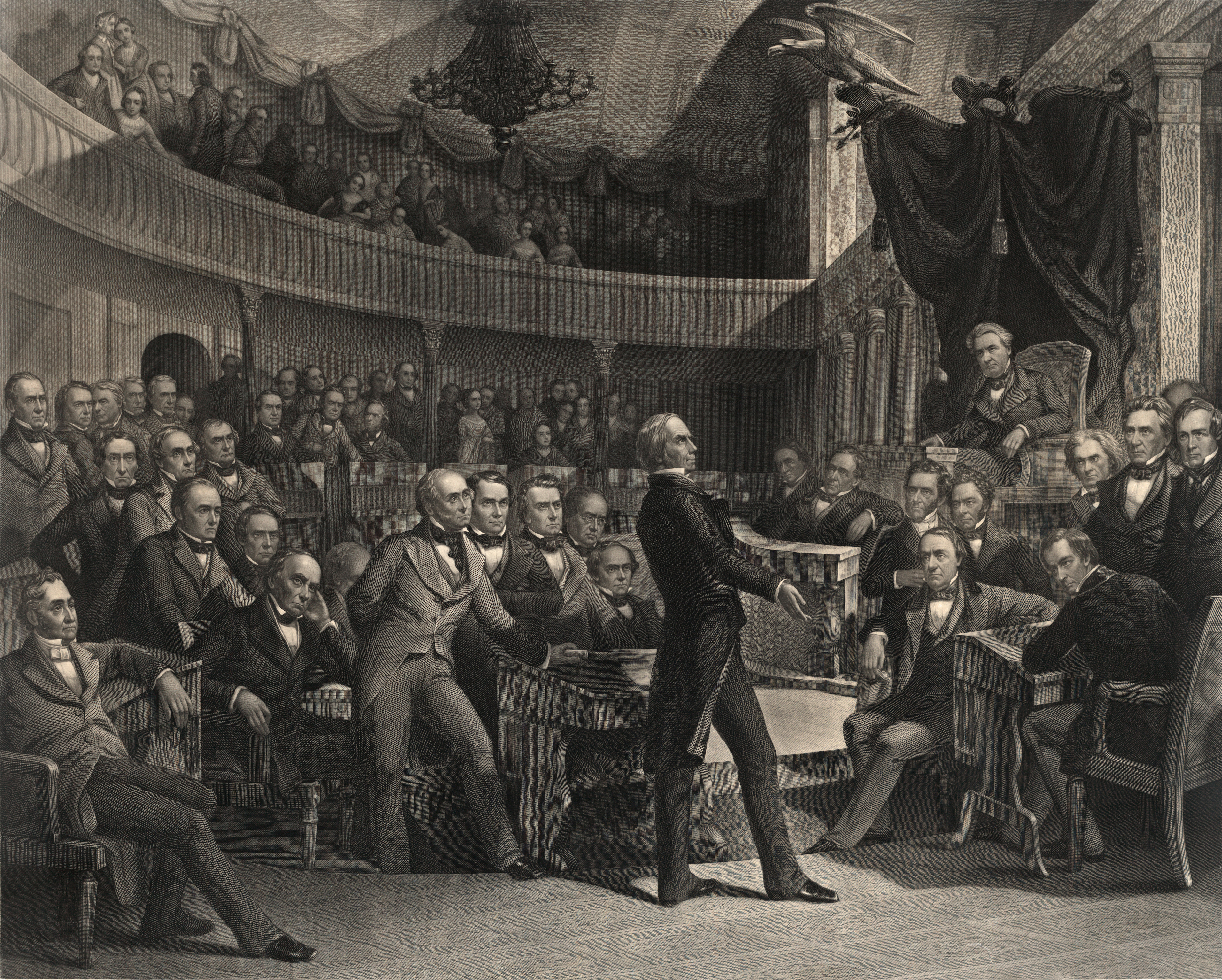
In 1850, 30 years after passage of the Missouri Compromise, Henry Clay engineered another compromise in response to the status of slavery in the land just acquired by the United States from the Mexican-American War. The Compromise established a series of five laws intended to balance the interests of the North and the South over the issue of slavery.
- California was admitted to the Union as a free state. The Southern proposal to split California at the 35th parallel was not approved.
- Other land gained from the Mexican-American War, such as the Utah and New Mexico territory, would determine the slave issue through popular sovereignty. The Wilmot Proviso (which would have banned slavery in all of this territory) was defeated.
- Texas, already a part of the United States, sacrificed its claim to the New Mexico Territory and land north of the 36-30 line.
- The slave trade (not slavery) was abolished in Washington, D.C.
- The Fugitive Slave Law of 1850 was introduced: it stated that any runaway slaves that were found in the North had to be returned to the South. Any northerner that assisted a runaway slave would be breaking the law, and would be fined and/or jailed. This was a huge concession to the South and proved extremely unpopular among Northerners and slaves, who had built up an effective Underground Railroad by this time. Paradoxically, the law greatly improved participation in the abolitionist movement.
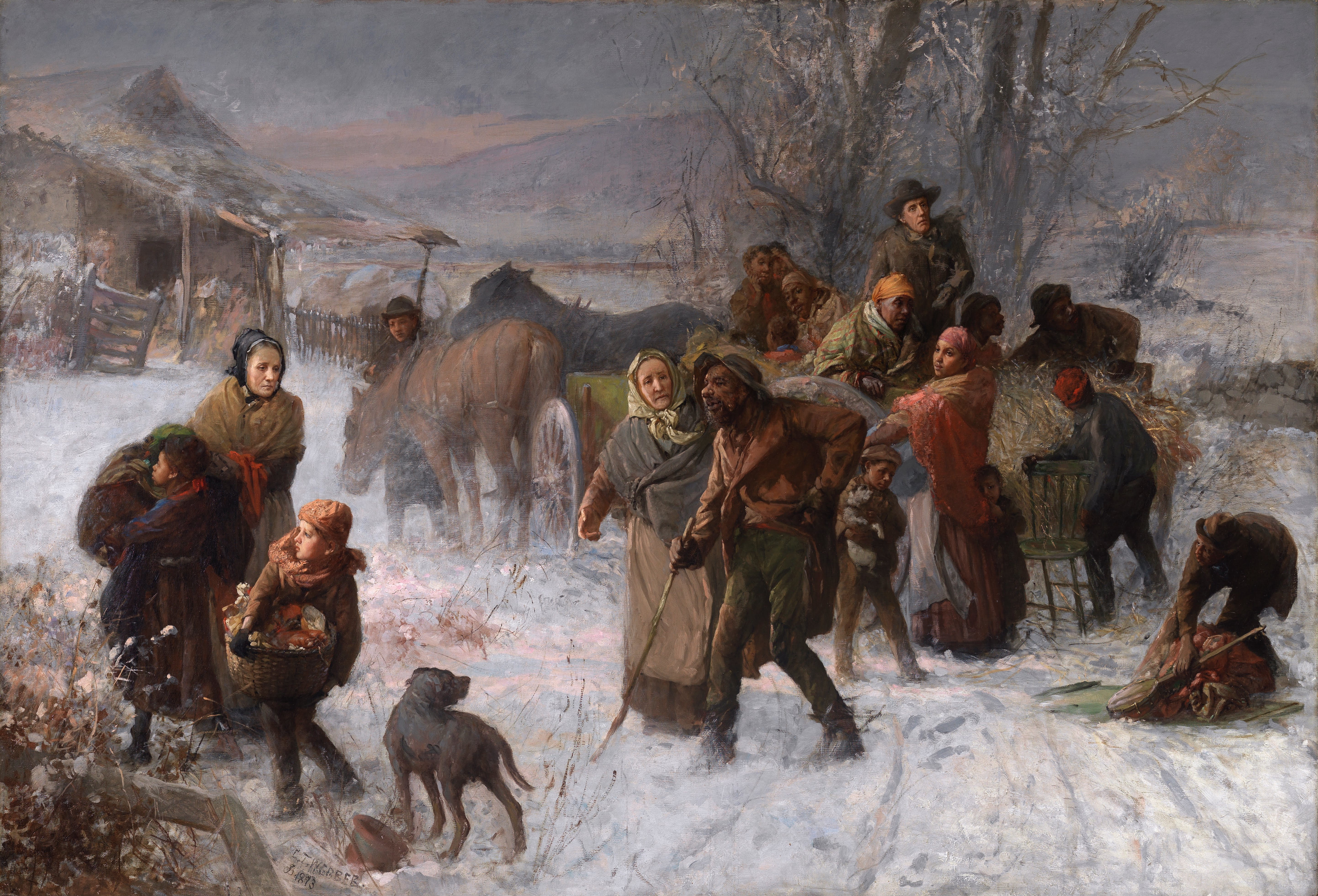 |
| The Underground Railroad, Charles Webber, 1893 |
See United States History I.29 for connections between the Fugitive Slave Law and the Underground Railroad.
For more on the Underground Railroad, see Gateway to Freedom: The Hidden History of the Underground Railroad. Eric Foner, W.W. Norton, 2015
The 1850 compromise was crafted by Senators Stephen Douglas and Daniel Webster in addition to Clay. John C. Calhoun vehemently disagreed with parts of the compromise, seeing it as infringing upon the South's constitutional right to hold slaves (see below).
The compromise was another in a long line of measures trying to calm the tensions between the North and the South, and postpone armed conflict. While it offered a momentary solution, it ultimately caused significant opposition from both sides.
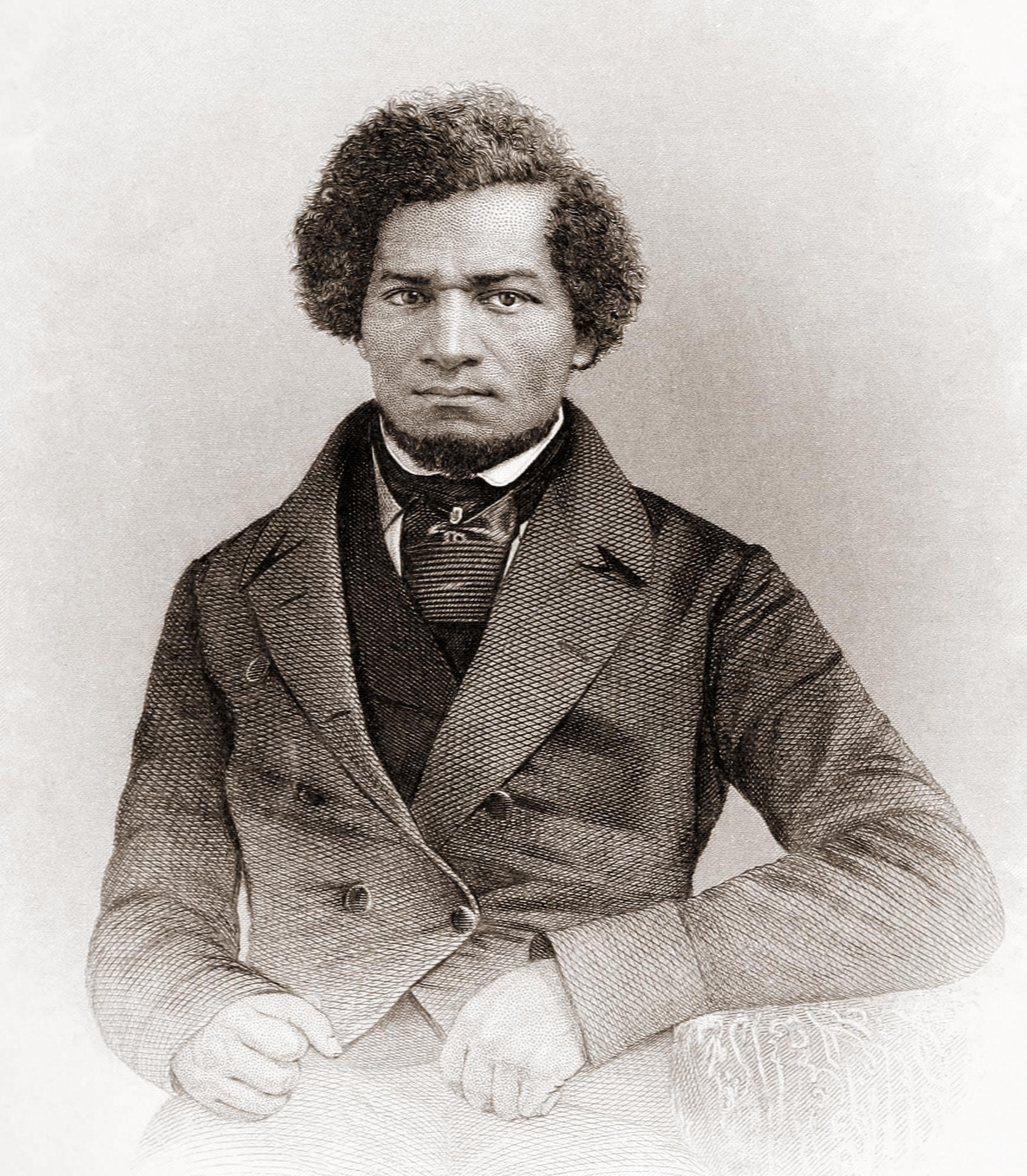 |
| Portrait of Frederick Douglass, 1855 |
John C. Calhoun on the Compromise of 1850: Despite being in ill health at the time, John C. Calhoun was passionately opposed to the Compromise of 1850. This is the full text of his speech, which had to be read by another senator on his behalf.
Frederick Douglass on the Fugitive Slave Act: Frederick Douglass was a passionate opponent of the Fugitive Slave Act of 1850. Previously a small minority, the Act encouraged many Northerners to be active abolitionists.
Henry Weeden, an free African-American Boston abolitionist, challenged the Fugitive Slave Act when he refused to tailor a coat for a US Marshal.
Africans in the Making of America: Clip from a documentary about the Compromise of 1850 and the Fugitive Slave Act.
There is an interesting video from C-SPAN reenacting the Lincoln Douglass debate. Here is an excerpt from this debate focusing on the Compromise of 1850.
E. the publication of Harriet Beecher Stowe’s Uncle Tom’s Cabin (1851-1852)
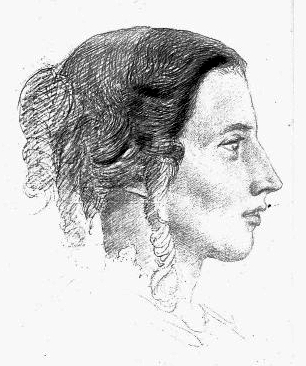
See Influential Literature Page on Uncle Tom's Cabin
Harriet Beecher Stowe’s Uncle Tom’s Cabin (1851-1852)
a. After the Fugitive Slave Law was passed, Stowe's efforts in abolitionism increased, and began writing her novel, Uncle Tom’s Cabin.
b. One of the most renowned abolitionists in American history.
c. Researched slavery by interviews slaves and slave owners.
d. Wit the help of William Lloyd Garrison (the editor of The Liberator: an abolitionist newspaper), she published fictional sketches on slavery.
e. Stowe's criticism was especially effective because she was a white woman and daughter of a respected Presbyterian minister, Lyman Beecher.
e. Many supporters of Uncle Tom’s Cabin were in Great Britain, and Harriet Beecher Stowe went on a tour to send the message against slavery.
f. When Great Britain considered to join the South as an ally, Stowe reminded them of their dedication to the slaves.
 Uncle Tom’s Cabin was written in 1852 (Click here to hear chapters read aloud):
Uncle Tom’s Cabin was written in 1852 (Click here to hear chapters read aloud):
- The novel is centered on Uncle Tom, a black slave. The novel portrays the inhumane treatment of slaves and the Christian love and faith that could overcome anything, including slavery.
- Increased the abolitionist movement in the North and angered the South. The South did not approve of the books criticism on slavery
- Abraham Lincoln met with Stowe and stated “So you’re the little woman who wrote the book that made this great war!”
- By the end of its first week Uncle Tom’s Cabin sold 10,000 copies (a lot for the time) and about 300,000 the first year.
- The book was translated into 60 different languages.
- The South said it was a false account of slavery, and attempted to ban the book in the South. They retaliated with books that promoted slavery including Aunt Phillis’s Cabin.
- The book created Black stereotypes including the dark-skinned and affectionate mammy and Uncle Tom who was the faithful servant to the white master.
Click for a link to a short biography on Harriet Beecher Stowe which details her early life and influences behind her abolitionist views.
Solomon Northrup's Twelve Years a Slave
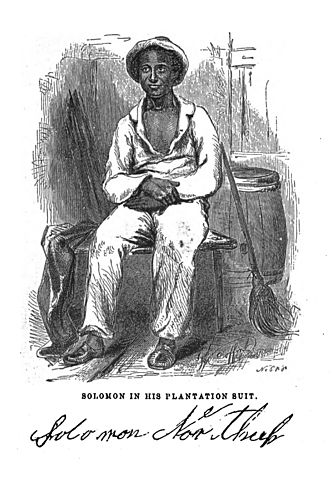 |
| Sketch of Solomon Northup, 1855 |
In 1853, only one year after Harriet Beecher Stowe's controversial book was published, Solomon Northup published his personal account of being a free-born African American only to be captured and sold into slavery. His memoir, Twelve Years a Slave, is a slave narrative shedding light on the violence in Louisiana. Much of his memoir actually supports Stowe's fictional story since the area in which he was enslaved was in the same area as Stowe's fictional plantation.
In 2013, the film 12 Years a Slave, directed by Steve McQueen, was based on Northup's memoir.
- Here is an on-line edition of Twelve Years a Slave: Narrative of Solomon Northup, a Citizen of New-York, Kidnapped in Washington City in 1841, and Rescued in 1853.
- On February 2, 2014, CBS Sunday Morning published a video about Chiwetel Ejiofor, the actor who plays Solomon Northup in 12 Years a Slave.
- The video discusses his apprehensions to playing the part and his reasoning for why agreed, which includes a trip from the Nigerian slave market to the Georgian slave market.
- Click here for the trailer for 12 Years a Slave, and click here for the full movie (NOTE: the film has an R rating for violence/cruelty, some nudity and brief sexuality).
Other narratives of escaped slaves were also published at the time, usually highly critical of the institution of slavery and written with the attempt to instill change.
- In Running a Thousand Miles for Freedom (link is to a short summary) the escaped slave couple of William and Ellen Craft tell their story of escape from slavery where the light-skinned Ellen poses as a white woman traveling to the North with her slave companion, William. Tracked down due to the Fugitive Slave Act, William and Ellen eventually had to move to Great Britain.
F. the Kansas-Nebraska Act (1854)
Interactive Timeline for the Kansas-Nebraska Act
a. Passed by Congress May 30, 1854, engineered by Illinois Senator and future presidential candidate Stephen Douglas.
b. Repealed the Missouri Compromise (no slaves states allowed above the 36°30´ parallel) by invoking the idea of popular sovereignty.
c. People within Kansas and Nebraska had the right to decide if their territories would be free or slave through the idea of popular sovereignty.
d. Groups rushed into the Kansas territory before the election to stuff the ballot.
e. The conflict over the free and slave status of the Kansas-Nebraska Territory became known as Bleeding Kansas
f. Exposed issues with the idea of popular sovereignty.
Click here for more information and primary source documents.
 Lesson Plan: The Kansas-Nebraska Act
Lesson Plan: The Kansas-Nebraska Act
Indian Territories west of the Mississippi including the Kansas-Nebraska Territory. The Idea of Westward Expansion meant massive relocation for the Native American Tribes that lived in these newly claimed American Territories.
Bleeding Kansas occurred as a result of this act. Bleeding Kansas is when abolitionists from the north came down to Kansas in an attempt to vote against slavery in the new territory. As a result, thousands of armed southerners came to stop the state from become slave free. As a result of this political fight, many died in bleeding Kansas (8).
For primary sources of bleeding Kansas please go to this link: Bleeding Kansas Primary Sources.
For an exploration into the role of women in western emigration and Bleeding Kansas, see this thesis paper produced at Wichita State University.
Clarina Irene Howard Nichols was a woman who emigrated to Kansas and played a crucial role in advocating for women and African-Americans, supporting suffrage and the Underground Railroad. She gave public speeches on these issues following the passage of the act, and became a national symbol for women, downplayed in our history of the pre-Civil War years.
This interactive map details key locations on the border between Kansas and Missouri that played crucial roles in both Bleeding Kansas and the early Civil War.
G. the Dred Scott Supreme Court case (1857)
Dred Scott (1857)
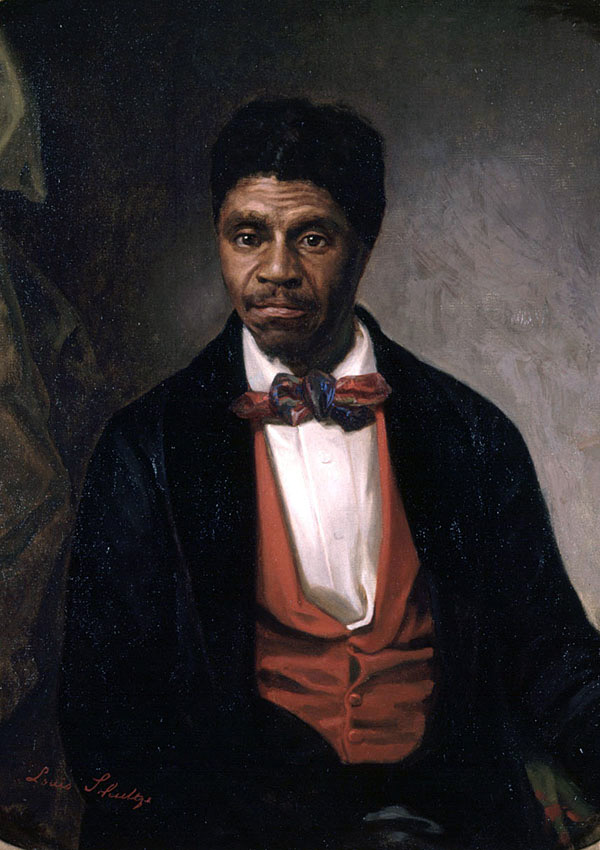
The case of Dred Scott involved an African American man (Dred Scott) who sued for his, his wife's, and his two daughters' freedom from their white master due to their residence in lands where slavery was legally outlawed (the Wisconsin territory, although now the lands he resided in are in Illinois and Minnesota).
- Scott's case eventually made it up to the Supreme court In Dred Scott v. Sanford (1857), and the ruling became a landmark decision.
- The Supreme Court declared that all African Americans were not and could not become citizens of the United States.
- It also declared the Missouri Compromise of 1820 was unconstitutional, because the federal government could not have any constitutional power to regulate slavery.
For a more detailed story on Dred Scott please check out the following link from PBS: Dred Scott.
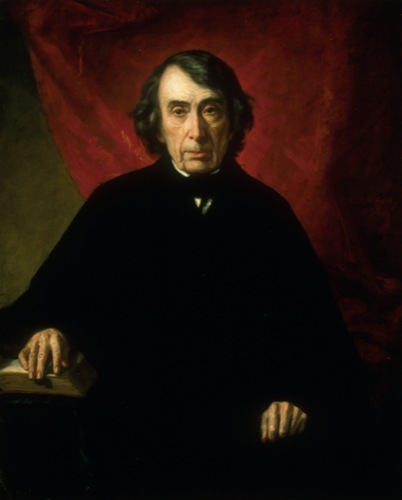 |
| Roger Taney, Chief Justice |
Here is the Dred Scott decision text itself: Dred Scott Court Case
Click here for a biography on Dred Scott.
Supreme Court Justice Benjamin Robbins Curtis who began his law career in Northfield, Massachusetts wrote a dissent in the Dred Scott Case, stating it was "not true, in point of fact, that the Constitution was made exclusively by the white race." African Americans were "in every sense part of the people of the United States [as] they were among those for whom and whose posterity the Constitution was ordained and established." (quoted from "Franklin County's U.S. Supreme Court Justice," The Recorder, May 3, 2013, p. 6). Curtis also served as chief defense council during the impeachment of President Andrew Johnson.
For more on Curtis' decision see Famous Dissents.
 The following link leads to a lesson plan which can be used when teaching about the case: Dred Scott lesson plans.
The following link leads to a lesson plan which can be used when teaching about the case: Dred Scott lesson plans.
H. The Lincoln-Douglas Debates (1858)
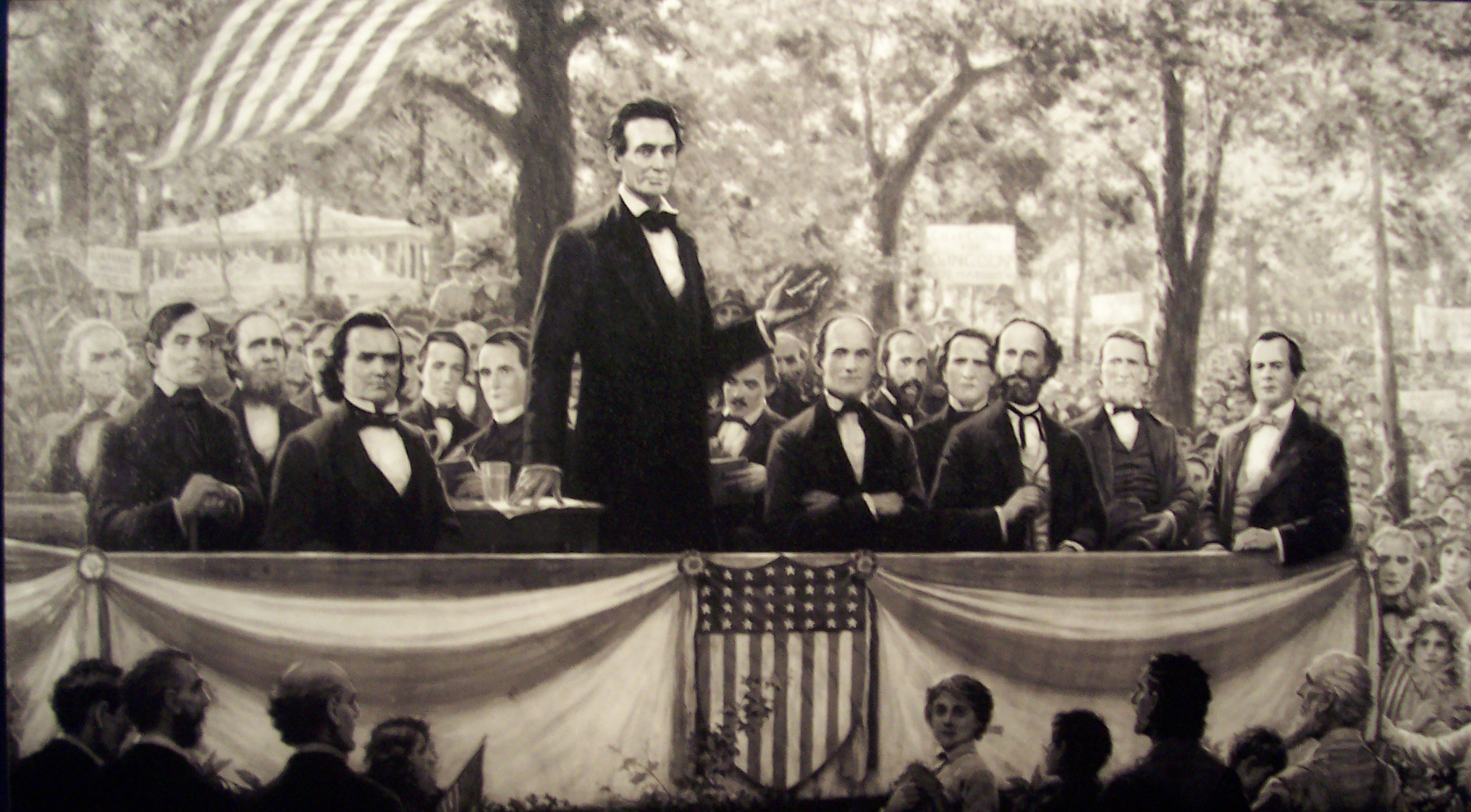 These debates took place between Stephen Douglas, incumbent, and Abraham Lincoln, challenger, for a Senate seat from Illinois. Lincoln lost the election, but the debates gave him attention that set the groundwork for his Presidential election.
These debates took place between Stephen Douglas, incumbent, and Abraham Lincoln, challenger, for a Senate seat from Illinois. Lincoln lost the election, but the debates gave him attention that set the groundwork for his Presidential election.
- They debated in 7 of 9 Congressional Districts. The first speaker would speak for one hour. The second speaker would then speak for an hour and a half, followed by a half hour rebuttal from the first speaker.
- Douglas spoke first in four of the debates. These debates centered around the issue of whether slavery should be allowed to expand to new territories.
- Click here to learn about Stephen Douglas.
2009 Reenactment of the Lincoln-Douglas Debates: On the 200th anniversary of Lincoln's birthday, Grand Valley's Hauenstein Center for Presidential Studies and the Gerald R. Ford Presidential Museum presented a reenactment of the famous debates. This is part 1 of 9 parts.
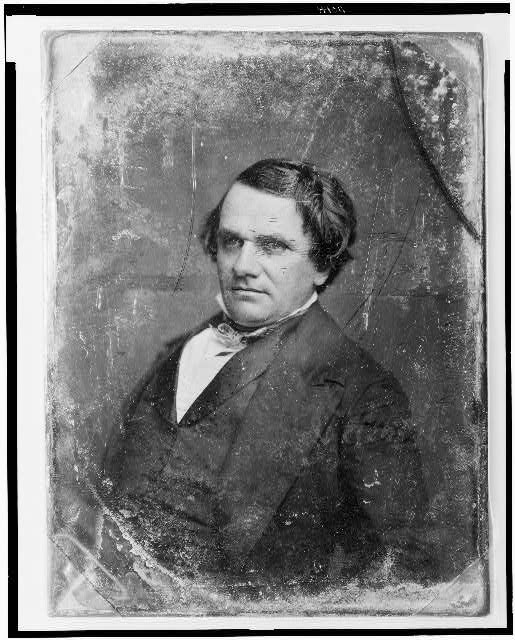 |
| Stephen Douglas |
Click here for transcripts of each debate.
Click here for newspaper articles on the debates, maps, images, and lesson plans on the debates.
Podcasts of the Lincoln-Douglas debates, as interpreted by two Lincoln scholars; this link also gives good summaries of the debates
The following link provides an amazing overview of the Lincoln-Douglas debates as well as explaining Lincoln's political career: Debate Article.
I. John Brown’s raid on Harper’s Ferry (1859)
 |
| Harper's Weekly: U.S. Marines attacking the firehouse which Brown used as a fort |
John Brown (Born May 9th 1820, Torrington CT) inherited a great deal of his anti-slavery views from his father Owen, who was integral in the founding of Oberlin College and was committed to its abolitionist principles. The bulk of what would contribute to his later life's work, however, developed during his time spent in Springfield, MA. In 1840 Brown was briefly employed by Oberlin as a surveyor of lands in Virginia, where he spent a great deal of time around Harper's Ferry, exploring the Allegheny Mountains, and formulating his plans for what would become his life's work.
John Brown, Springfield, and the Secret Six
- After moving to Springfield in 1846, Brown soon ingratiated himself in Springfield's active abolitionist societies.
- Here he became acquainted with leaders like Frederick Douglass, Harriet Tubman, and prominent business leaders who had kept their abolitionist views secret. (See here for info on the Secret Six)
John Brown and Bleeding Kansas
- In 1855 John Brown was splitting time between Elmira, NY on his family homestead and Springfield, MA, planning and raising money for his great plan to end slavery. Two of his sons wrote to him from Kansas, where they were involved in border skirmishes over the Kansas-Nebraska Act, asking for aid from their father in the form of money and/or weapons. John Brown decided to put his plans and fundraising on hold, travelled down to Kansas bringing a wagonload of guns and ammunition, and soon took command of a regiment that fought the pro-slavery forces throughout the conflict.
Raid on Harper's Ferry
- After his exploits in Kansas, Brown had become infamous for his radical antislavery views, and his willingness to use violence to achieve those means. After decades of planning and fundraising, John Brown rented a farmhouse near Harper's Ferry, VA, and called on his supporters, his family, and his fellow soldiers from Kansas. 18 men showed up, and on October 16th of 1859, Brown revealed to his group the exact intricacies of his plan.
- On early October 17th, Brown and his followers entered the town of Harper's Ferry, surrounded and took the Armory. Their intent, unbeknownst to anyone but the raiders and a select few, was to capture the arms and ammunition stored there, and funnel the contraband and some raiders into slave plantations. There they would foment massive slave insurrections by sheer force of numbers and weapons, hoping that slaveowners would surrender without bloodshed, and they could make their way to the next plantation with an even larger force.
- The incredibly ambitious plan failed, and Brown and his party were soon after surrounded by federal forces under the command of soon to be General Robert E. Lee.
- For more detailed information on John Brown's raid and why it failed, see below mentioned books Midnight Rising by Tony Horrowitz and John Brown by W.E.B. Dubois
Resources on John Brown as well as Nat Turner's Rebellion and Gabriel's Conspiracy are available from the Death or Liberty exhibit at the University of Virginia Library.
See here for information on abolitionism in Springfield, MA and Northampton, MA
Information on John Brown and his relationship with "General" Harriet Tubman can be found here
Click here for student-made videos examining John Brown's Raid from students at the Harper's Ferry Middle School.
Click here to listen to John Brown's Body, sung by Union soldiers during the course of the Civil War.
Click for a link to a short History Channel segment on John Brown's Raid.
"A Plea for Captain John Brown"is Henry David Thoreau's famous speech defending Brown.
Click here to read John Brown's letters from prison to his wife and children.
 Midnight Rising: John Brown and the Raid That Sparked the Civil War. Tony Horowitz.
Midnight Rising: John Brown and the Raid That Sparked the Civil War. Tony Horowitz.
- As the author noted: "This really hits the country like a thunderbolt. A bi-racial band of abolitionists seizing a symbol of American power just 60 miles from the Capitol and vowing to free every slave in the South. It hit America in 1859 a little like 9/11 did us" (quoted in Massachusetts Daily Collegian, March 14, 2012, p. 1)
John Brown by W.E.B. DuBois, published in 1909, still serves as the foremost biography of the abolitionist. DuBois describes in great detail the meetings and correspondence between Brown and Douglass.
Mary Ellen "Mammy" Pleasant was a former slave and businesswoman who helped to fund John Brown's Raid on Harper's Ferry. Click here to learn more about Pleasant, her extraordinary accomplishments, and her influence on John Brown.
- Click here to read more about her.
Click here for a map of John Brown's raid in West Virginia.
Click here for Lesson Plans on John Brown's raid
J. the election of Abraham Lincoln (1860)

In the Election of 1860, Abraham Lincoln ran on the platform of the newly formed Republican party (they had only previously participated in the presidential election of 1856, where their candidate John Fremont lost to Democrat James Buchanan.
- Lincoln ran against two Democratic candidates, Stephen Douglas and John Breckenridge, and John Bell of the Constitutional Union Party.
- Breckenridge mostly appealed to the Southern slaveowning interests
- Bell to the border states (he argued slavery was constitutionally protected, but opposed secession), and
- Douglas advocated popular sovereignty.
- Lincoln did not campaign as an abolitionist, but as someone committed to stopping the spread of slavery.
- Lincoln won only 39.7% of the popular vote, but carried a majority in the electoral college due to his domination of Northern states (see the map below).
- Lincoln won 180 electoral votes to Breckenridge's 72, Bell's 39, and Douglas' 12.
- So, he won the election despite not even being on the ballot in the majority of southern states (Alabama, Arkansas, Florida, Georgia, Louisiana, Mississippi, North Carolina, South Carolina, Tennessee, and Texas).
- This greatly angered Southern political interests, as they felt the new President did not represent them, and feared that he was a closet abolitionist. Lincoln's election was a major contributor to the impending outbreak of Civil War.
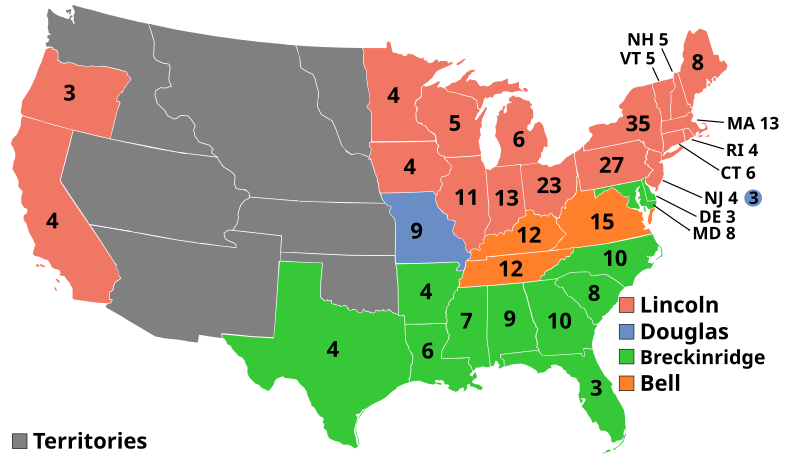 |
| 1860 Presidential Election map |
1860 Presidential Election Popular Vote by State
Click here for a collection of political cartoons about the 1860 election from Harper's Weekly .
Yale Lecture on John Brown and The Election of Abraham Lincoln given in Spring 2008.
Declaration of Causes of Seceding States (Georgia, Mississippi, South Carolina, Texas).
Alfred Whital Stern presented a collection on Lincoln to the Library of Congress in 1953. This collection contains letters by Lincoln, articles about Lincoln and other topics of the time. Click here to view it.
 EDSITEment lessons on Slavery, The Crisis of the Union, The Civil War and Reconstruction.
EDSITEment lessons on Slavery, The Crisis of the Union, The Civil War and Reconstruction.
The Election of Abraham Lincoln eventually led to the formation of African-American military units to fight the Civil War
Learn more about this important development in the following video: The Civil War: Black Soldiers
Additional Sources:
[1] Wilmot Proviso. (2007). In Wikipedia [Web]. Retrieved April 16, 2007, from http://en.wikipedia.org/wiki/Wilmot_Proviso.
[2] Popular Sovereignty. (2007). In Wikipedia [Web]. Retrieved April 16, 2007, from http://en.wikipedia.org/wiki/Popular_sovereignty.
[3] David Wilmot. (2007). In Wikipedia [Web]. Retrieved April 16, 2007, from
http://en.wikipedia.org/wiki/David_Wilmot.
[4] The Compromise of 1850. (2007). In Wikipedia [Web]. Retrieved April 16, 2007, from http://en.wikipedia.org/wiki/Compromise_of_1850.
[5] Harriet Beecher Stowe. (2007). In Wikipedia [Web]. Retrieved April 16, 2007, from http://en.wikipedia.org/wiki/Harriet_Beecher_Stowe.
[6] Uncle Tom's Cabin. (2007). In Wikipedi [Web]. Retrieved April 16, 2007, from http://en.wikipedia.org/wiki/Uncle_Tom%27s_Cabin.
[7]The Compromise of 1850 (2010). In Youtube. Retrieved April 2, 2010, from http://www.youtube.com/watch?v=4qKcHZKsM0M
[8] http://www.pbs.org/wgbh/aia/part4/4p2952.html
[9] The Lincoln-Douglas Debates of 1858. http://www.nps.gov/liho/historyculture/debates.htm.
Comments (0)
You don't have permission to comment on this page.